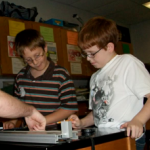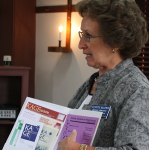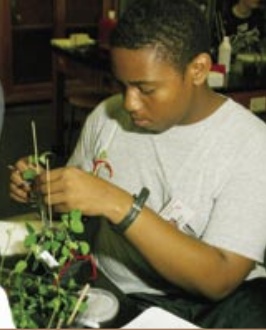The 1990s: Expanding Our Reach
1990:
 The Center receives our first of an eventual four grants from the Jacob J. Javits
Gifted and Talented Students Education Act. This federal program supports research
on gifted and talented students with an emphasis on serving underrepresented groups.
The 1990 grant funds the three-year Enhancing Educational Opportunities for Gifted
Middle School Students project, conducted in coordination with the Kentucky Department
of Education and seven school districts throughout the state. The initiative focuses
on identifying gifted students who might otherwise be overlooked, providing professional
development to teachers to craft theme-based units of study across disciplines, piloting
these units during the school year and in The Center’s summer programs, and enhancing
the teachers’ abilities to provide services to gifted students.
The Center receives our first of an eventual four grants from the Jacob J. Javits
Gifted and Talented Students Education Act. This federal program supports research
on gifted and talented students with an emphasis on serving underrepresented groups.
The 1990 grant funds the three-year Enhancing Educational Opportunities for Gifted
Middle School Students project, conducted in coordination with the Kentucky Department
of Education and seven school districts throughout the state. The initiative focuses
on identifying gifted students who might otherwise be overlooked, providing professional
development to teachers to craft theme-based units of study across disciplines, piloting
these units during the school year and in The Center’s summer programs, and enhancing
the teachers’ abilities to provide services to gifted students.
 KAGE, which seeks to expand and support educational opportunities for the state’s gifted
youth, is first housed at The Center. It remains there to this day, and we also provide
a staff member to help run its operations. The relationship between The Center and
KAGE increases each organization’s impact on and essential presence in Kentucky.
KAGE, which seeks to expand and support educational opportunities for the state’s gifted
youth, is first housed at The Center. It remains there to this day, and we also provide
a staff member to help run its operations. The relationship between The Center and
KAGE increases each organization’s impact on and essential presence in Kentucky.
1992:
 Super Saturdays launches. The program offers minds-on, hands-on enrichment classes at WKU for high-ability
and high interest elementary students. The instructors are recruited from exceptional
teachers in the Bowling Green area, WKU faculty, undergraduate students, and graduate
students in gifted studies. We also offer seminars on issues related to gifted children
for parents, many of whom travel long distances for their children to attend. Originally
offered once a year in early winter to students in grades one through six as two-hour
classes on five Saturdays in a row, the program evolves to twice a year for students
in grades one through eight as two-and-a-half-hour classes on four Saturdays in a
row. Mary Evans serves as the first organizer of the program, followed by Heather
Kessler and Gail Hiles. As of 2017, almost 26,800 children in grades 1-8 have attended.
Super Saturdays launches. The program offers minds-on, hands-on enrichment classes at WKU for high-ability
and high interest elementary students. The instructors are recruited from exceptional
teachers in the Bowling Green area, WKU faculty, undergraduate students, and graduate
students in gifted studies. We also offer seminars on issues related to gifted children
for parents, many of whom travel long distances for their children to attend. Originally
offered once a year in early winter to students in grades one through six as two-hour
classes on five Saturdays in a row, the program evolves to twice a year for students
in grades one through eight as two-and-a-half-hour classes on four Saturdays in a
row. Mary Evans serves as the first organizer of the program, followed by Heather
Kessler and Gail Hiles. As of 2017, almost 26,800 children in grades 1-8 have attended.
- We add a one-week trip during spring break to our educational schedule, with interested adults, often family members of traveling students, eventually joining the trips. The most common destinations in spring are London and Paris, with Italy added into the rotation in 2011.
1993:
- The Center receives our second Javits grant for Restructuring Primary Education: Responding to Kentucky’s Educational Reform. The three-year project compares gifted students at primary schools in Kentucky with multi-age, multi-ability, and "ungraded" classrooms to those at "graded" schools out of state.
- The Center starts a formal, three-year association with Russia when we establish a Russian/American educational partnership through United States Information Agency grants and the Citizen Exchange Council. In each of the three years, ten Russian students attend VAMPY, and we send ten students to Rostov-on-Don in Russia.
- We offer our first Update on Gifted Education Workshop, held in partnership with KAGE.
1996:
- To continue the work of our second Javits project, we receive a three-year grant from the United States Department of Education Office of Educational Research and Improvement.
- The Center first collaborates with The College Board to hold Vertical Team Training Institutes in a variety of areas to help teachers who teach middle school, pre-AP, and AP courses coordinate their curriculum and instruction. The initial institute is for English teachers; we eventually offer training in social studies, math, science, and, as a national pilot program, world languages. More than 450 teachers from throughout Kentucky and other states participate in the institutes. The last one is held in 2009.
- We hold our first of nineteen Leadership Institutes, bringing in experts from around the country to guide more than 650 teachers, counselors, and administrators in developing leadership skills in young people with an eye towards the educational standards of Kentucky schools.
1997:
- In the first step of the work that becomes The Carol Martin Gatton Academy of Science and Mathematics in Kentucky, Julia and WKU physicist Charles McGruder propose the establishment of a two-year residential math and science high school at WKU for Kentucky students to the Kentucky Council on Postsecondary Education.
1998:
- The Center receives the first of five one-year grants from the Kentucky Council on Postsecondary Education's Dwight D. Eisenhower Mathematics and Science Program for the Raising Achievement in Middle School Science (RAMSS) project. This initiative aims to lift the learning ceiling in middle grade science classes and to raise students’ scores on state tests to the level of proficient or distinguished.
 The Center publishes the inaugural issue of our magazine, The Challenge. Edited by The Center’s Associate Director Tracy Inman and designed by Marcus Dukes
of the WKU Division of Public Affairs, it shares the events, hopes, and accomplishments
of The Center community with an audience of students, educators, and parents. We initially
publish The Challenge twice a year; we add a third annual issue in 2013. By 2017 it is sent to 21,800 homes
across the country and throughout the world. As a complement to the magazine, we also
establish a website, and the page for The Challenge includes links to every issue, all of which are archived online.
The Center publishes the inaugural issue of our magazine, The Challenge. Edited by The Center’s Associate Director Tracy Inman and designed by Marcus Dukes
of the WKU Division of Public Affairs, it shares the events, hopes, and accomplishments
of The Center community with an audience of students, educators, and parents. We initially
publish The Challenge twice a year; we add a third annual issue in 2013. By 2017 it is sent to 21,800 homes
across the country and throughout the world. As a complement to the magazine, we also
establish a website, and the page for The Challenge includes links to every issue, all of which are archived online.
1999: The Challenge receives the Blue Pencil Award from the Kentucky Association of Government Communications.
History of The Center by Decade
The 2000s: Taking Steps to Secure Our Future
The 2010s: Continuing our Traditions/Exploring New Possibilities
Some of the links on this page may require additional software to view.

